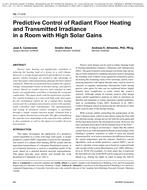Description
Passive solar heating can significantly contribute to reducing the heating load of a house in a cold climate. However, a careful design approach and predictive or anticipatory control strategies are needed to take advantage of solar heat gains while maintaining adequate thermal comfort conditions. While the use of thermal mass enables the capture, storage, and gradual release of thermal energy, anticipatory control (based on weather forecast and estimates of other loads) can significantly contribute to keeping the occupants comfortable. This paper deals with the application of predictive control techniques in a zone with high solar heat gains, for the coordinated control of: (a) a radiant floor heating system and (b) a dynamic fenestration system with automatically controlled solar transmittance. The implementation and testing of advanced control strategies is facilitated through a simple transfer function model, obtained from a more complex thermal network model. The effect of modifying the setpoint curve depending on the expected solar radiation is also examined, as well as the impact of weather forecast inaccuracies.
Citation: ASHRAE Transactions, Volume 117, Part 2, Montreal, QC
Product Details
- Published:
- 2011
- Number of Pages:
- 14
- File Size:
- 1 file , 4.2 MB
- Product Code(s):
- D-ML-11-015




